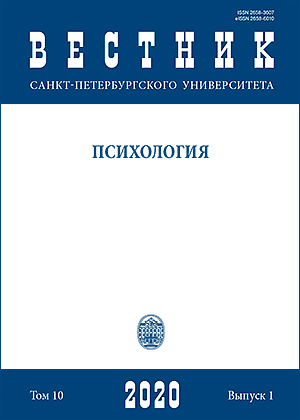The psychological concept of S.L.Rubinstein in the context of the ideas of I.V.Goethe and V.I.Vernadsky
DOI:
https://doi.org/10.21638/spbu16.2020.101Abstract
The article examines the similarities and differences in the concepts of S.L.Rubinstein, I.V.Goethe and V.I.Vernadsky. At the center of the comparative interdisciplinary analysis are the ideas of the opponent and the reference circles and the cognitive style of scientists and artist. The theory of a reference circle is introduced, a circle of people whose ideas stimulated the development of concepts of other scientists and artists. The influence of Leonardo da Vinci on S.L.Rubinstein, I.V.Goethe and V.I.Vernadsky is illustrated. Attention is given to the fact that the various hypostases of Leonardo’s work became a reference for the various searches of Rubinstein, Goethe and Vernadsky, for the formation of new areas of the science of color, nature and technology, the spiritual essence of man. The significance of the works of K.Levin and existential psychology for S.L.Rubinstein, as well as his concept of the inner world of man, his exosphere is explored. The connections of reference circles and the cognitive style of scientists are revealed. The pantheism of I.V.Goethe became the basis of his approach to the harmonious unity of rational and intuitive knowledge, nature and culture, combining science and art. The complementarity, compensatory, and non- harmonious unity of intuition and logic, science and art is characteristic for S.L.Rubinstein and V.I.Vernadsky. At the same time, activity or action becomes the leading one for Goethe and Rubinstein. For I.V.Goethe, first of all, it is the action aimed at rebuilding the world and for S.L.Rubinstein it is the unity of external and internal activity and the priority of internal activity in a person’s restructuring of his spiritual world. The analysis of the specifics of the social situation in the life of all three creators reveal similarities, which partially determined the peculiarities of their cognitive style and attitude to science and art. If science becomes the basis of self-development and selfrealization, then art is an incentive for self-understanding, self-designing and construction of one’s own spiritual world.
Keywords:
reference circle, cognitive style, social situation, nature and culture
Downloads
References
References
Downloads
Published
How to Cite
Issue
Section
License
Articles of "Vestnik of Saint Petersburg University. Psychology" are open access distributed under the terms of the License Agreement with Saint Petersburg State University, which permits to the authors unrestricted distribution and self-archiving free of charge.




